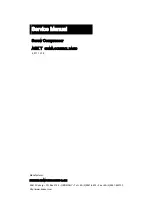
9. KEEP CHILDREN AWAY
Do not let visitors contact compressor extension cord. All visitors should be kept safely
away from work area.
10. DRESS PROPERLY
Do not wear loose clothing or jewellery. They can be caught in moving parts. Wear protective
hair covering to contain long hair.
11. DON’T ABUSE CORD
Never yank it to disconnect from receptacle. Keep cord from heat, oil and sharp edges.
12. MAINTAIN COMPRESSOR WITH CARE
Follow instructions for lubricating. Inspect cords periodically and if
damaged, have repaired by authorized service facility. Inspect extension cords periodically and replace if damaged.
13. OUTDOOR USE EXTENSION CORDS
When compressor in used outdoors, use only extension cords intended for use
outdoors and so marked.
14. STAY ALERT
Watch what you are doing. Use common sense. Do not operate compressor when you are tired.
compressor should never be used by you if you are under the influence of alcohol, drugs or medication that makes you
drowsy.
15. CHECK FOR DAMAGED PARTS AND AIR LEAKS
Before further use of the compressor, carefully checked the guard
and other parts for damage to make sure that it will operate properly and perform its intended function. Check for
alignment of moving parts, binding of moving parts, breakage of parts, mounting, air leak, and any other conditions
that may affect its operation. A guard or other part that is damaged should be properly repaired or replaced by an
authorized service center unless otherwise indicated elsewhere in this Instruction Manual. Have defective pressure
switches replaced by authorized service center. Do not use compressor if switch does not turn it on and off.
16. NEVER USE COMPRESSOR FOR APPLICATIONS OTHER THAN THOSE SPECIFIED
Never use compressor for
applications other than those specified in the Instruction Manual. Never use compressed air for breathing or
respiration. Never stand on the compressor.
17. HANDLE COMPRESSOR CORRECTLY
Operate the compressor according to the instructions provided herein. Never
allow the compressor to be operated by children, individuals unfamiliar with its operation or unauthorized personnel.
18. KEEP ALL SCREWS, BOLTS AND COVERS TIGHTLY IN PLACE
Keep all screws, bolts, and plates tightly mounted.
Check their conditions periodically.
19. KEEP MOTOR AIR VENT CLEAN
The motor air vent must be kept clean so that air can freely flow at all times. Check
for dust build-up frequently.
20. OPERATE COMPRESSOR AT THE RATED VOLTAGE
Operate the compressor at voltages specified on their
nameplates. If using the compressor at a higher voltage than the rated voltage, it will result in abnormally fast motor
revolution and may damage the unit and burn out the motor.
21. NEVER USE A COMPRESSOR WHICH IS DEFECTIVE OR OPERATING ABNORMALLY
If the compressor appears to
be operating unusually, making strange noises, or otherwise appears defective, stop using it immediately and arrange
for repairs by an authorized service center.
22. DO NOT WIPE PLASTIC PARTS WITH SOLVENT
Solvents such as gasoline, thinner, benzine, carbon tetrachloride,
and alcohol may damage and crack plastic parts. Do not wipe them with such solvents. Wipe plastic parts with a soft
cloth lightly dampened with soapy water and dry thoroughly.
23. USE ONLY GENUINE REPLACEMENT PARTS
Replacement parts not original may void your warranty and can lead
to malfunction and resulting injuries. Genuine parts are available from your dealer.
24. DO NOT MODIFY THE COMPRESSOR
Do not modify the compressor. Always contact the authorized service
center any repairs. Unauthorized modification may not only impair the compressor performance but may also result in
accident or injury to repair personnel who do not have the required knowledge and technical expertise to perform the
repair operations correctly.
25. TURN OFF THE PRESSURE SWITCH WHEN THE COMPRESSOR IS NOT USED
When the compressor is not used,
turn the knob of the pressure switch OFF, disconnect it from the power source and open the drain cock to discharge
the compressed air from the air tank.
26. NEVER TOUCH HOT SURFACE
To reduce the risk of burns, do not touch tubes, heads, cylinder and motors.
27. DO NOT DIRECT AIR STREAM AT BODY
Risk of injury, do not direct air stream at persons or animals.










































